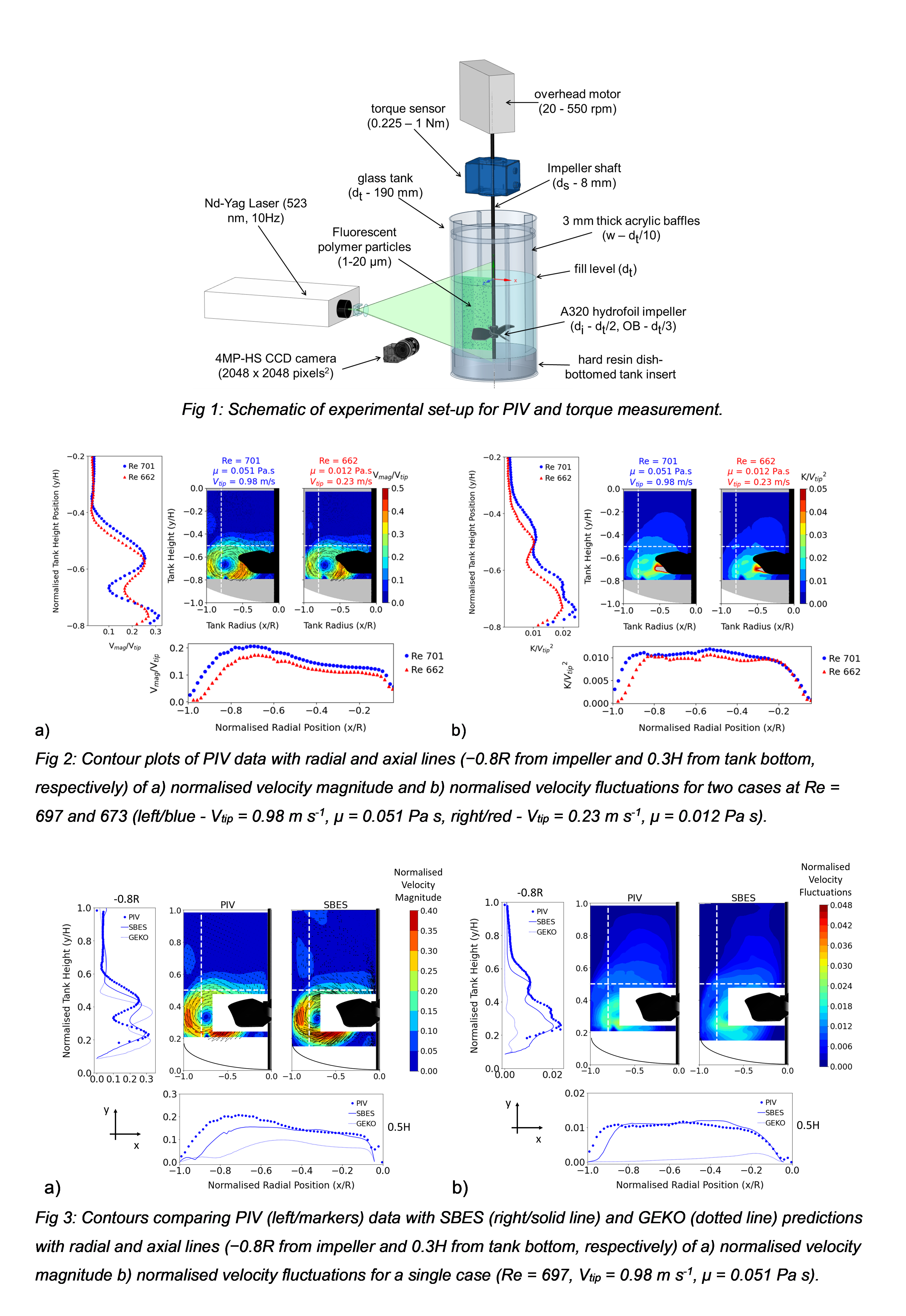Validated Computational Fluid Dynamics (CFD) simulations when applied to industrial flows are powerful predictive tools that facilitate rapid modification and improvement of existing processes. The complex rheological properties of home and personal care products typically evolve during manufacture, as functional microstructures build. This typically causes the apparent viscosity to increase, thus causing the flow to move from turbulent, through transitional, to the laminar flow regime in the mixer. In the transitional flow regime, hydrodynamic instabilities create unsteady flows that are difficult to predict using existing laminar or turbulence closure models that were developed for flows with high Reynolds number turbulence [1]. Hence, further advancements in the effective application of CFD to simulate mixing in the transitional flow regime are required.
Focusing on transitional regime flows in a stirred tank with a hydrofoil impeller [1], a dynamic turbulence closure model – stress blended eddy simulation (SBES) – has been evaluated alongside a generalised k-ω shear stress transport model (GEKO), through comparison with experimental 2D Particle Image Velocimetry (PIV) and torque measurements (Fig 1). Unsteady flows of water, Newtonian glycerol solutions (40–100 wt%), and non-Newtonian CMC solutions (0.1–1.5 wt%) were measured over a wide range of values of Reynolds number, Re, from 8 to 25,000, spanning laminar to turbulent flow via the transitional regime. For both the Newtonian and non-Newtonian fluids, two flow scenarios were investigated for each value of Re, scaled by changing tip speed (Vtip) according to apparent fluid viscosity. Using Ansys Fluent (version 2024R1), transient CFD simulations were built for selected cases of interest with a ~2.4M element mesh, giving mesh independence. Proper orthogonal decomposition (POD) of PIV data and periodic averaging of CFD allowed exploration of the impact of pseudo-turbulence arising from impeller blade and baffle periodicity.
PIV results indicated that, for constant viscosity, increasing Re augmented both the magnitude and fluctuations of velocity. However, when normalised by Vtip, velocity initially decreased with increasing Re for laminar flows before increasing through the transitional regime, then achieving independence of Re in fully turbulent flow. Normalised velocity fluctuations increased with Re across all flow regimes. The values of Re for which transition between these laminar and turbulent behaviours occur, and thus transitional regime boundaries, change depending on fluid viscosity. The transition to fully turbulent flow occurs at decreasing values of Re for increasing apparent fluid viscosity. Two cases with similar transitional Reynolds number (Re = 697 and 673) but different viscosity (μ = 0.051 and 0.012 mPa s) scaled by agitation speed (Vtip = 0.98 and 0.23 m s-1, respectively) exhibit almost similar flow hydrodynamics. Displaying similar normalised velocities (Fig 2a) and fluctuations (Fig 2b), which would be expected more in the fully turbulent regime.
Both GEKO and SBES closure models have been validated for torque prediction. However, SBES gives much better agreement between values of impeller and wall torque in the transitional regime. When comparing with PIV data (Fig. 3), SBES outperforms GEKO for predicting flow hydrodynamics, at the cost of additional computational requirement. Machine learning is to be implemented with the aim of modifying the GEKO constants to give a more accurate prediction, as given by SBES, providing a more industrially relevant model.
References
- Mendoza, B. Lopes Bañales, E. Cid, C. Xuereb, M. Poux, D. F. Fletcher, J. Aubin, Chemical Engineering Research and Design, 132 (2018) 865-880.
- Menter, A. Hüppe, A. Matyushenko, D. Kolmogorov, Applied Science, 11 (2021) 2459-2473.
Acknowledgments
GW is supported by the EPSRC Centre for Doctoral Training in Formulation Engineering (EP/S023070/1) at the University of Birmingham and Unilever Port Sunlight, UK.

